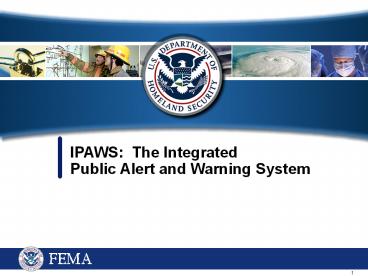IPAWS Overview - PowerPoint PPT Presentation
Title:
IPAWS Overview
Description:
IPAWS working to upgrade participating systems to be CAP compatible. NOAA. Cellular broadcast ... Operational in community EOC and Weather Field Office; ... – PowerPoint PPT presentation
Number of Views:125
Avg rating:3.0/5.0
Title: IPAWS Overview
1
IPAWS The Integrated Public Alert and Warning
System
2
History of Emergency Alerts
- CONELRAD
- EBS
- EAS
- Limitations
- In the past, all alerts came through radio and
television transmission - Alerts were audio-only
- Alerts were only in English
- Daisy-chain limitations
3
What is the Integrated Public Alert and Warning
System (IPAWS)?
- IPAWS will take the existing Emergency Alert
System (EAS) and add new ways to warn people of
imminent threats - The public will receive alerts via
- Cell phones - Radio
- Email - Residential telephone
- Television - others TBD
- The mission is to ensure the President can
communicate with State, Local, and Tribal
governments and the public in times of war or
national emergency - IPAWS capabilities will also be available to
emergency managers
4
IPAWS Architecture
- One message will reach the public through every
available communication path - A message can originate at the Federal, State, or
Local level - The message will go to the IPAWS
aggregatorservers that will gather the messages
and authenticate them, then - The message will go through multiple distribution
paths to reach every available communications
device - IPAWS is developing standards and protocols to
increase interoperability among alert and warning
systems
5
IPAWS Architecture
Message Disseminators
Emergency Managers IPAWS compliant
CAP Alert Origination Tools
Public
Emergency Alert System
IP access networks
Federal
AM FM Satellite Radio Digital Analog Cable
Satellite TV
Digital EAS
PBS
IPAWS
Cellular Broadcast
Cellular Phones
State
Cellular Carriers Networks
Web Browsers, widgets, web sites
Internet Services
Local
message aggregation, authentication, adaption
NOAA
State / Local Unique Alerting Systems (e.g. ETN,
Siren, Signage systems)
IP distribution networks
6
Progress to Date
- The first standard IPAWS has developed is called
the Common Alerting Protocol (CAP) - Allows a single alert message to be routed over
many systems - Can easily work with language translation
software for non-English speakers, hearing
impaired and other special audiences - IPAWS working to upgrade participating systems
to be CAP compatible - NOAA
- Cellular broadcast
- For cell phone alerts, the interface is finished
that allows a message to go from the IPAWS system
to the cell phone users - Geo-Targeted Alerting System (GTAS) pilot
projects
7
Geo-Targeted Alerting System (GTAS)
- What Is GTAS
- Why GTAS
- How GTAS Works
- GTAS Connectivity
- GTAS Locations
8
What is GTAS?
- GTAS is a joint pilot project between NOAA and
FEMA providing Emergency Managers with a new
software tool - Integrates NOAAs advanced weather information
and warning infrastructure with FEMA IPAWS
dissemination systems - Its a JAVA based system with a graphical user
interface. - Provides targeted warnings to the public in event
of toxic release via reverse 911 technology
9
Why GTAS?
GTAS strengthens the Nations ability to address
disasters and ensure the Nations jurisdictions
have adequate programs to effectively address all
hazards and minimize loss of life and property
- Presidential Executive Order 13407,
- Function 3 of Public Alert and Warning System
- Ensure the capability to adapt the distribution
and content of communications on the basis of
geographic location, risks, or personal user
preferences, as appropriate - Mitigates Current Gaps in Emergency Manager
Support - Modeling tools easy to use and understood by
those that do not have meteorology and
modeling/simulation training.
10
How GTAS Works?
- Provides targeted warnings to the public in event
of toxic release via reverse 911 technology - Integrates NOAAs advanced weather information
and warning infrastructure with FEMA IPAWS
dissemination systems - Operational in community EOC and Weather Field
Office - Interface to Commercial Mobile Alert System via
CAP messages.
11
GTAS Provides Emergency Manager a Easy to Use Tool
- GTAS provides information the emergency manager
needs to quickly identify the public that is at
risk - Uses a simple graphical user interface for system
managers - Provides collaboration tools, so the EM can work
with the experts at a WFO to clarify the
information that is being presented
12
Where GTAS will be Piloted in 2009
- Southern Region VI (Completed)
- Weather Field Office, Ft Worth, TX
- Dallas Emergency Operations Center (EOC)
- Western Region X
- Weather Field Office, Seattle, WA
- Washington State EOC
- City of Seattle EOC
- Eastern Region II
- Weather Field Office, New York City
- New York State EOC
- New York City EOC
- Central Region VII
- Weather Field Office, Pleasant Hill, MO
- Kansas State EOC
- Kansas City EOC
13
Conclusion
- The completion of the IPAWS system is estimated
for 2012 - IPAWS is in regular contact with the FEMA
Regional team. Please check there for updates. - News and other topics can be found on the IPAWS
website http//www.fema.gov/emergency/ipaws/index
.shtm - GTAS Pilot Project in Washington
14
Andrew Hendrickson Tribal Liaison FEMA Region
X andrew.hendrickson_at_dhs.gov 425-487-4784

